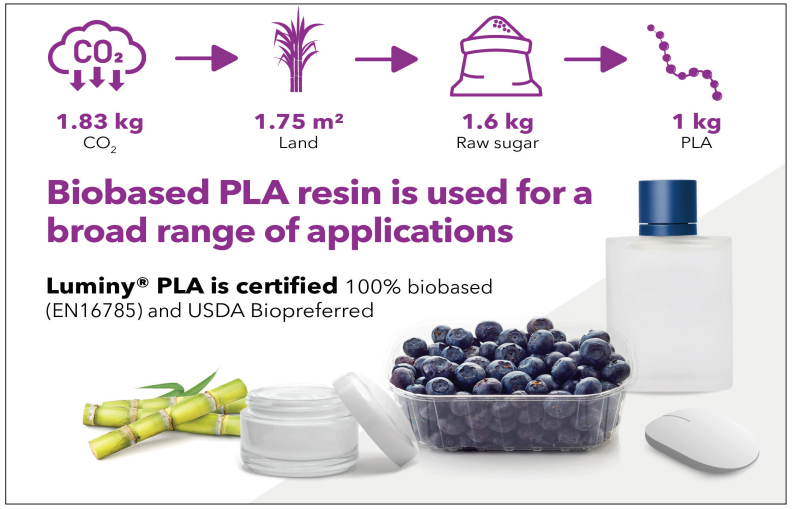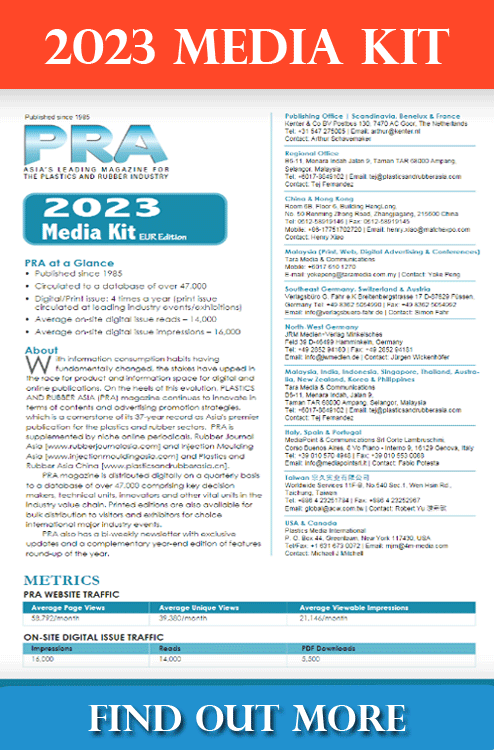Planting the future with PLA
In this edited version of a white paper by TotalEnergies Corbion, a 50/50 joint venture between TotalEnergies and Corbion, the company explains why its Luminy PLA family of bioplastics qualifies as sustainable under the EU taxonomy regulation.
Thailand, where Netherlands-based TotalEnergies Corbion has been operating a 75,000-tonne/year PLA plant in Rayong since 2018, is the second largest global exporter of sugarcane. Planting sugarcane is the starting point for Luminy PLA production.
After growing and harvesting the sugarcane, it is brought to a sugar mill to extract the sugar, which is fermented using microorganisms to produce lactic acid, an organic acid also produced by the human body.
TotalEnergies Corbion converts the lactic acid into PLA, a biopolymer that manufacturers can use in multiple applications from packaging to 3D printing to electronics.
PLA is a 100% biobased polymer
Different regional and international standards exist to measure biobased content in plastic materials. Typically, these rely on the carbon dating technique known as C14, which determines the origin of the carbon in the material. Carbon is the key building block of our planet, and roughly two sources of carbon exist: carbon from renewable resources or carbon from fossil resources. Biobased materials have a C14 activity of 100%, and fossil-based materials have an approximate 0% C14 activity.
In Europe, EN16875 is a regulation that specifies a method of determining the biobased content in products using the C14 method, while in the US, the US Department of Agriculture’s BioPreferred programme strictly monitor s third-party certifications and manufacturers’ claims regarding biobased content.
Thus, Luminy PLA is certified 100% biobased according to EN16785 and USDA BioPreferred programme.
Selecting feedstocks with the highest yields
As our population grows and global demand on resources increases, arable land will become scarce. It is, therefore, essential to use the most efficient crops available. Agricultural yields per hectare of arable land vary based on the type of crop and region. Sugarcane and sugar beet provide the highest carbohydrate yields per hectare of land used.
TotalEnergies Corbion sources its lactic acid from fermentation specialists and global market leader in lactic acid Corbion that says it predominantly uses the highest-yielding feedstocks regionally available: raw sugar from cane is used by its factories in Thailand and Brazil, dextrose from corn is used by its lactic acid production plant in the US, and raw sugar from sugar beet is used by its factories in Europe.
In addition to bioplastics production, lactic acid produced in these factories is also used in food ingredients, biochemical ingredients, and medical biomaterials.
Feedstock efficiency scores highly for PLA
In addition to crop yields, it is important to have an energy-efficient conversion from raw sugar to polymer. The term ‘feedstock efficiency’ as used here describes the conversion ratio of feedstock weight to final plastic polymer weight and is a combination of a theoretical efficiency (which differs per type of bioplastic) in combination with production efficiencies. This means that different types of bioplastics, produced using different production processes, will require different amounts of feedstock.
In terms of feedstock efficiency, PLA is one of the most efficient biopolymers: yielding 1 kg of PLA polymer for 1.6 kg of fermentable sugar feedstock. Other bioplastics can require 2.5-3 times more sugar feedstock to produce the same amount of plastic.
Ultimately, feedstock efficiency has a positive impact on land use. Additionally, all environmental impacts related to agriculture are correlated with the amount of feedstock used.
TotalEnergies Corbion produces PLA bioplastic made predominantly from raw sugar from cane in Thailand. Over the years, both Corbion and TotalEnergies Corbion have significantly improved the internal process yields and as mentioned above, is able to produce 1 kg of PLA using just 1.6 kg of raw sugar.
TotalEnergies Corbion also says that the European sugar beet and Thai sugarcane used as feedstocks for the production of its PLA bioplastics are “always GMO-free”.
Meanwhile, TotalEnergies Corbion's production plant is certified ISO 14001-Environmental Management System, ISO 9001 Quality Management System and ISO 45001 Occupational Health and Safety Management System.
Corbion’s Cane Sugar Code
TotalEnergies Corbion sources lactic acid from Corbion, and Corbion's Cane Sugar Code has been developed to describe expectations of its cane sugar suppliers to fulfil responsible sourcing commitment. The code is based on the definitions for sustainable sugarcane and derived products as set out by Bonsucro, a global, non-profit, multi-stakeholder organisation founded by WWF in 2005 to advance a more economically, environmentally, and socially responsible sugarcane sector.
Corbion’s code of conduct for cane sugar suppliers includes a general supplier code, applicable to all Corbion suppliers, as well as specific extensions directly relating to sugarcane farming in Thailand and Brazil.
A benchmarking study indicates that Corbion’s Code contains a broad set of robust principles and criteria that is well aligned with the principles and criteria laid down by Bonsucro and other relevant standards (RSB, ISCC, SMETA) for addressing raw materials, ethical and social compliance.
Biobased and European environmental frameworks: Taxonomy
TotalEnergies Corbion Luminy PLA produced in Thailand fully complies with EU Taxonomy regulations, meaning that it qualifies as a sustainable material within the framework of reducing environmental impact and mitigating climate change in the region. For plastics users, this demonstrates that they can substantially reduce their Scope 3 GHG emissions by replacing fossil-based plastics with PLA.

The EU taxonomy, which came into force on 12 July 2020, is a classification system with technical screening criteria for defining the specific requirements and thresholds for an economic activity to be considered as significantly contributing to a sustainability objective.
This provides companies, investors, and policymakers with appropriate definitions of which economic activities are environmentally sustainable. It also helps the EU to scale up sustainable investment and to implement the European green deal.
Land use for bioplastics does not compete with food production
Today’s feedstocks for bioplastics are grown on arable land. Land use for bioplastics production is minimal and does not compete with food productions in any way through 2027.
The European Bioplastics Association publishes annual market size data for the current and future years. Using these growth rates, one can estimate the overall impact of the bioplastics market on land use.
The data shows that, for example, in 2027, land used for growing feedstocks for bioplastics will account for only 0.058% of global agricultural area, a figure from which we can conclude that bioplastics do not negatively impact food production, a conclusion also supported by various independent reports, including those from the novaInstitute, Wageningen University and Research Centre and IfBB.
Thai raw sugar production is in the range of 12 million tonnes/year. Thailand has 16.81 million ha of arable land. In 2020/2021, the land used for sugarcane is estimated to be 1.75 million ha. This means that 10.41% of the arable land in Thailand is used for sugar production.
TotalEnergies Corbion has a production capacity of 75 kilotonnes of PLA; 1 kg of PLA requires 1.75 sq m of land, while 75 kilotonnes of PLA require 13,312 ha, which is 0.08% of Thai arable
(PRA)
Subscribe to Get the Latest Updates from PRA Please click here
©2023 Plastics and Rubber Asia. All rights reserved.

©2023 Plastics and Rubber Asia. All rights reserved.
Home Terms & Conditions Privacy Policy Webmail Site Map About Us
















